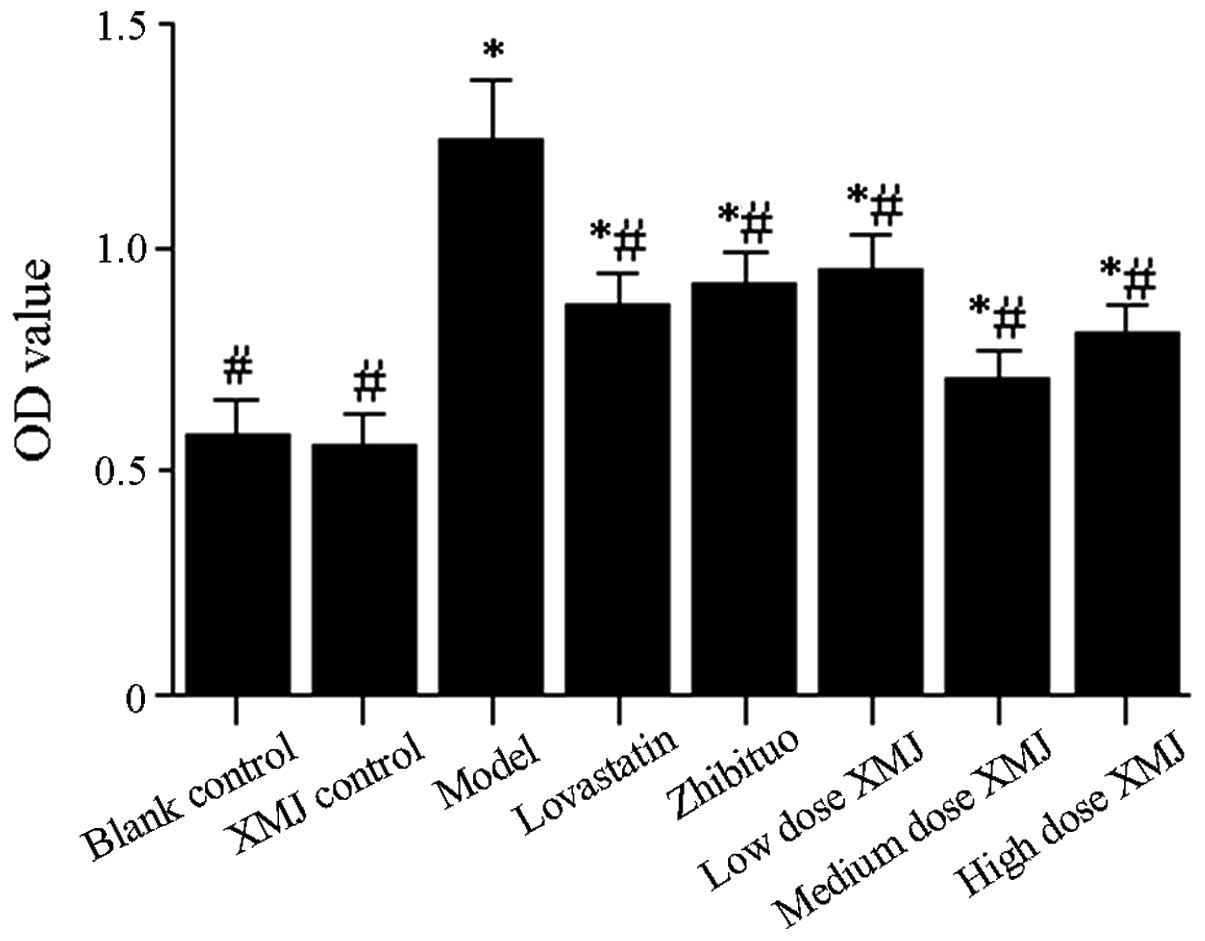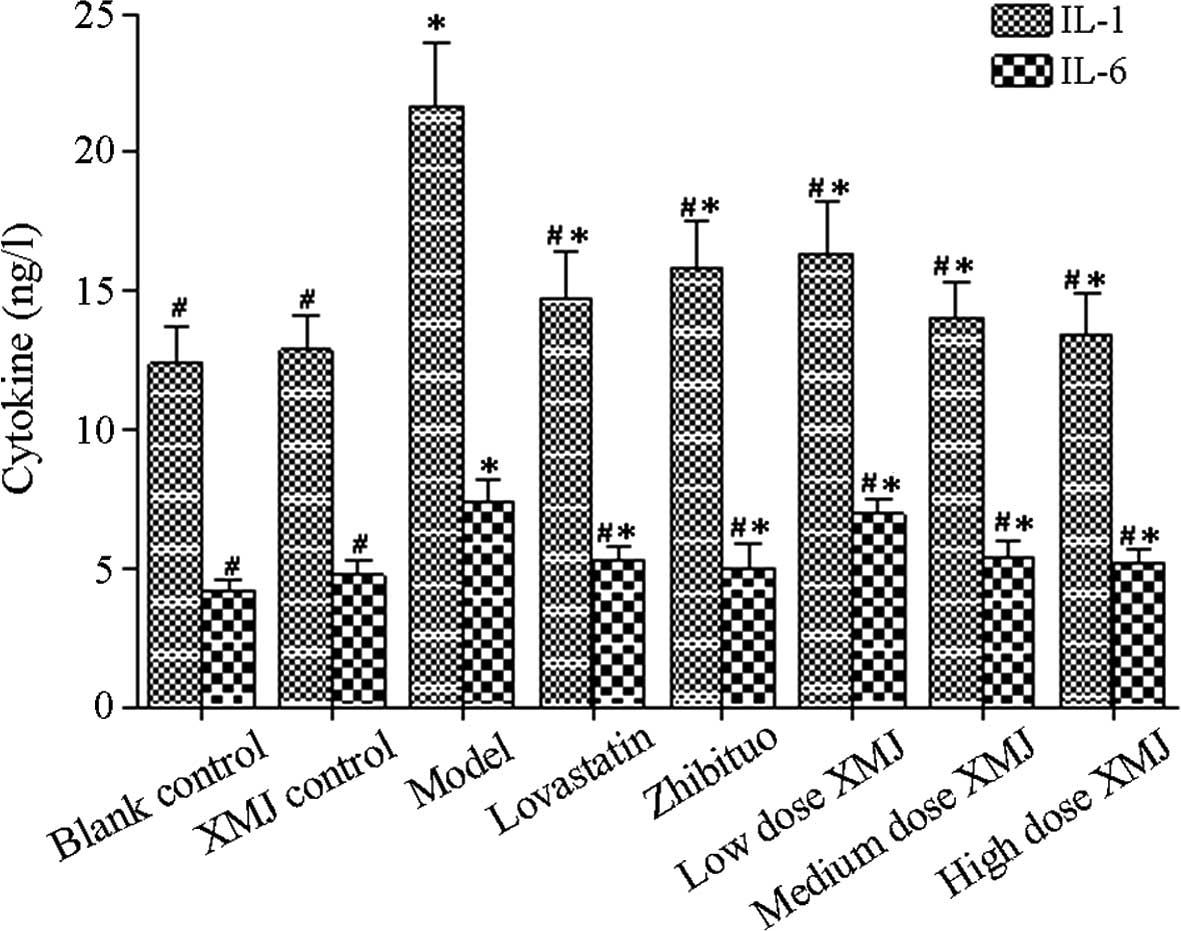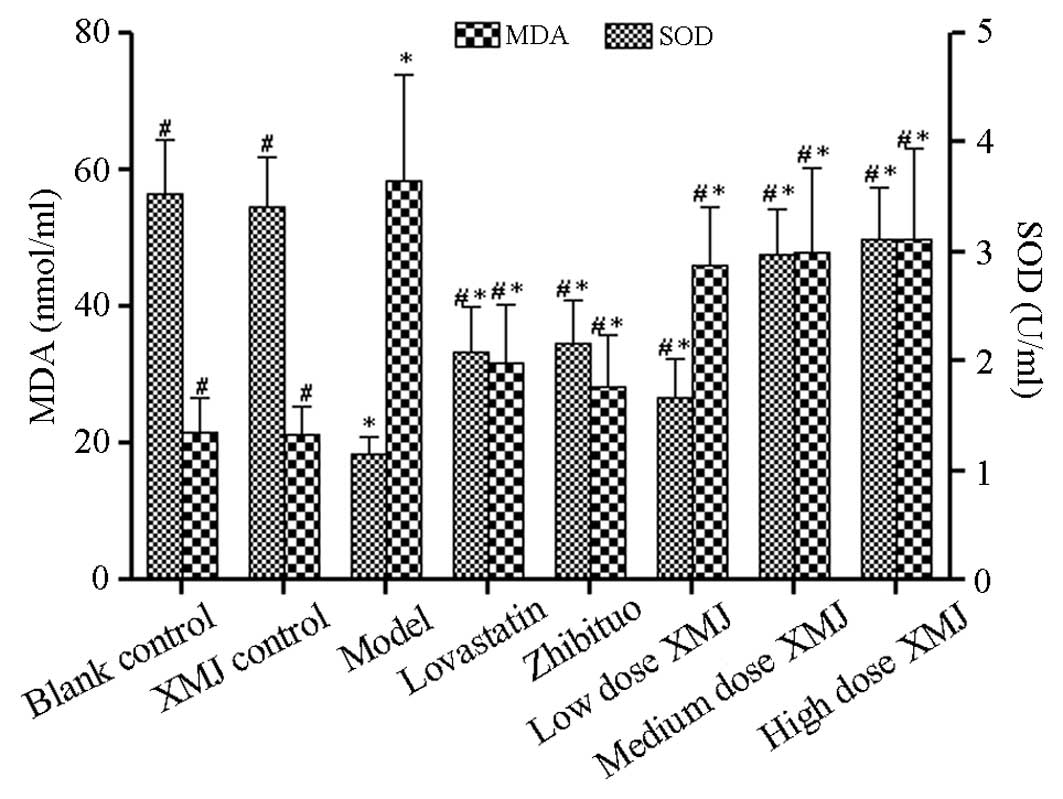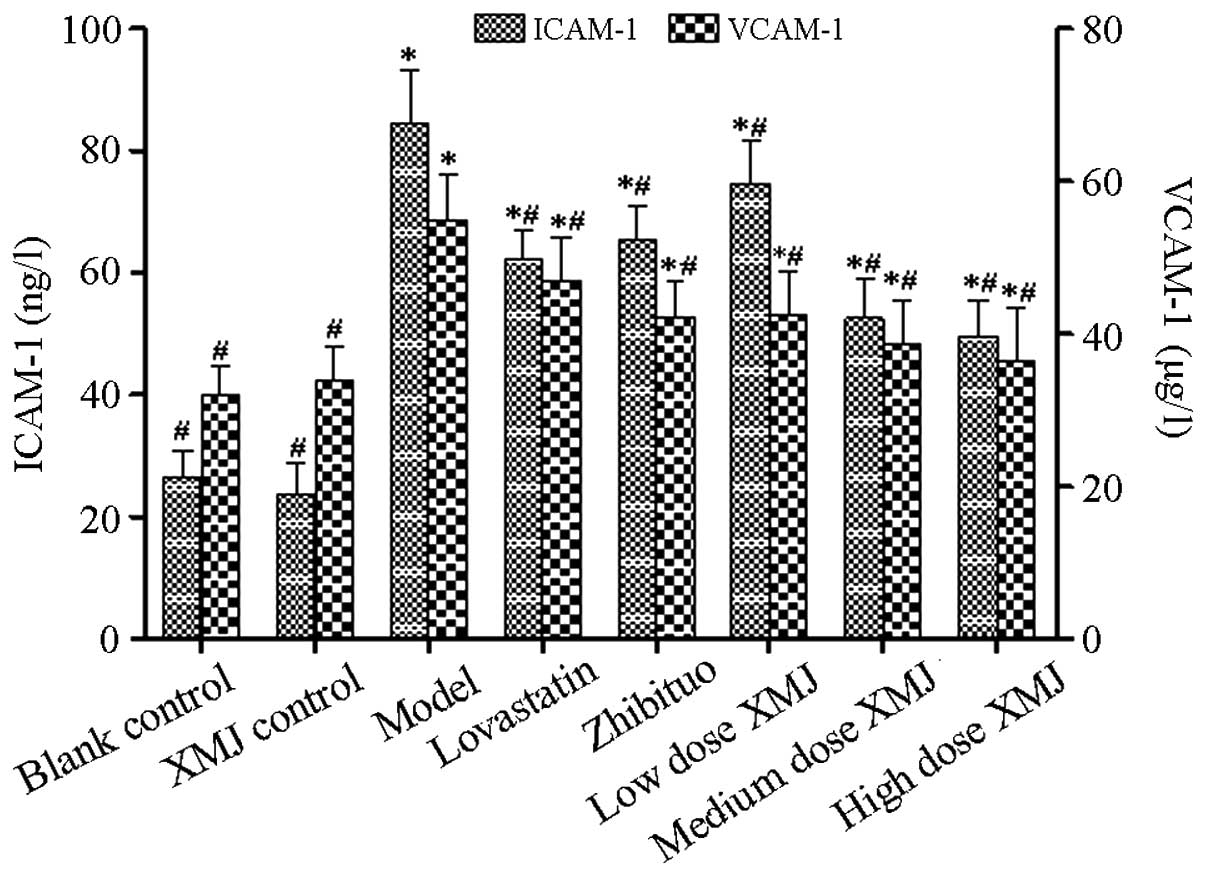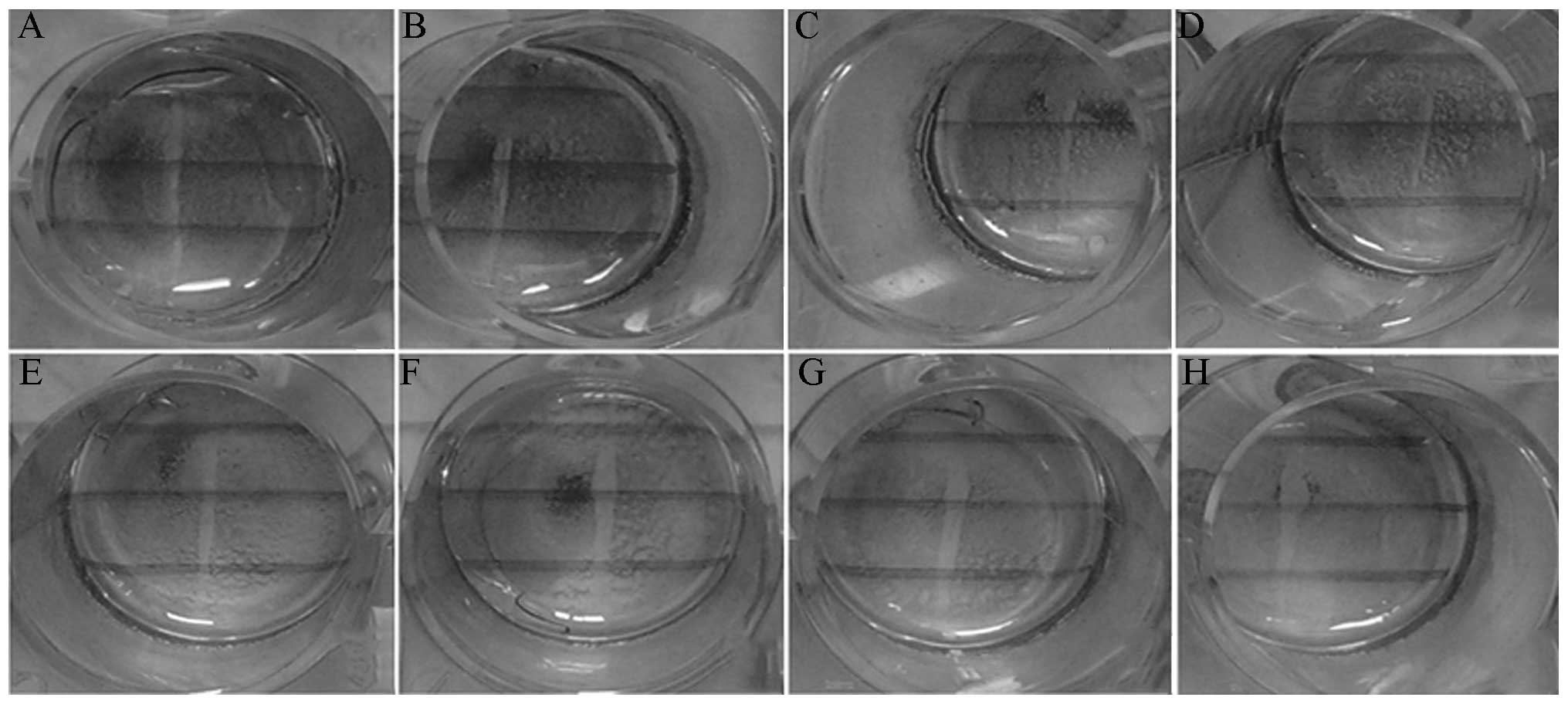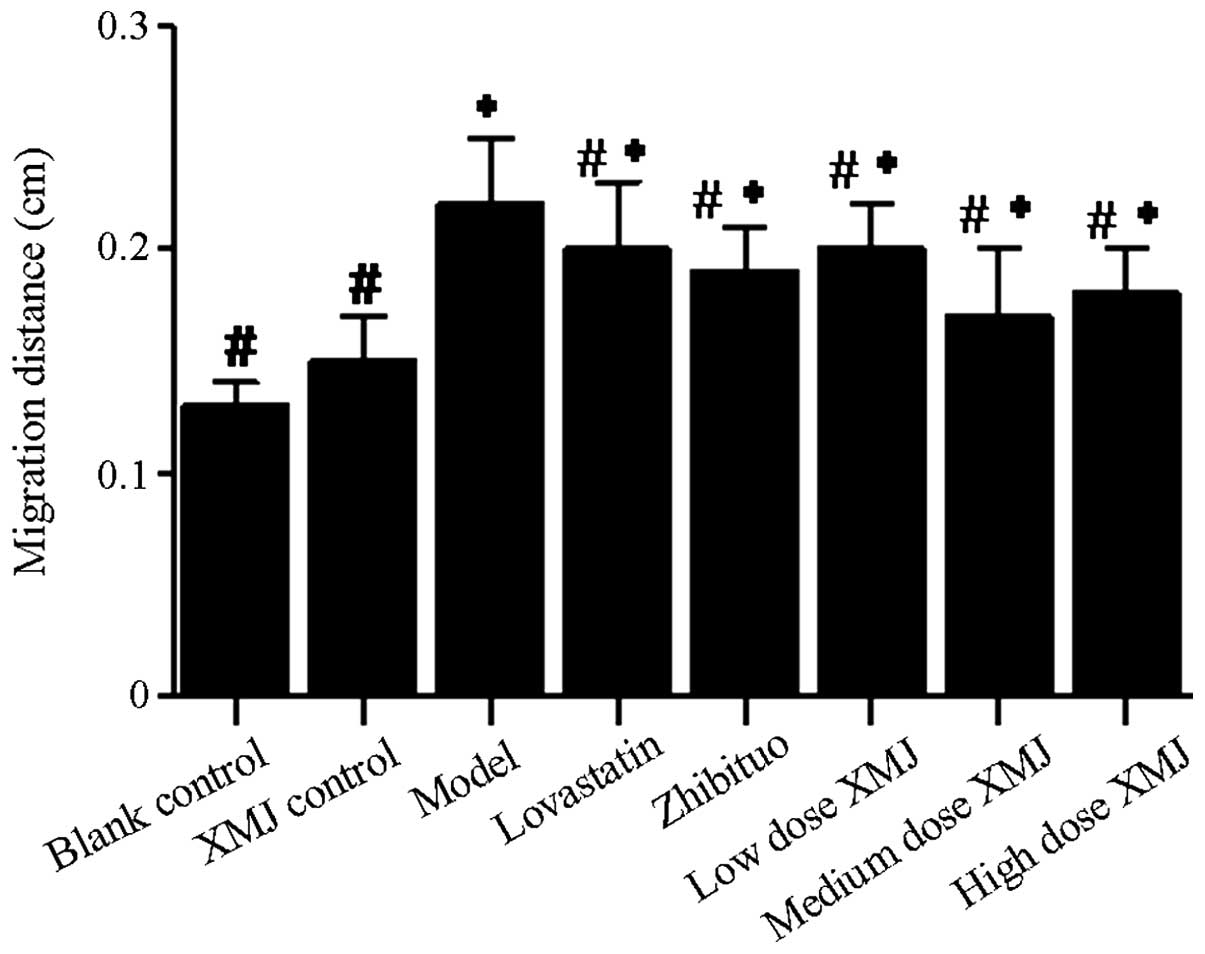Protective effect of the ultra-filtration extract from Xin Mai Jia on human aortic smooth muscle cell injury induced by hydrogen peroxide
- Authors:
- Published online on: October 25, 2013 https://doi.org/10.3892/etm.2013.1365
- Pages: 11-16
Abstract
Introduction
Arteriosclerosis (AS) is a chronic inflammatory disease. Reactive oxygen species (ROS) are produced during exposure to oxidative stress, such as hydrogen peroxide (H2O2), and bind to the nuclear receptor of vascular endothelial cells and smooth muscle cells (SMCs) as ligands. ROS directly regulate the gene expression of various types of signaling molecules, such as interleukin (IL), intercellular adhesion molecule (ICAM) and vascular cell adhesion molecule (VCAM), to enhance the adhesion and migration of monocytes to the tunica intima, which is vital in the early stage of AS (1–3). Various types of cells and inflammatory mediators participate in the occurrence of AS (4–7), particularly the vascular smooth muscle cells (VSMCs) of the tunica media. The VSMCs of the tunica media form SMC-derived foam cells after proliferation, phenotypic transition and migration to the intima in the presence of a stimulating factor. The VSMCs of the tunica media are significant in the early, middle and advanced stages of AS, as well as in the pathogenesis of vascular stenosis diseases. VSMCs are categorized as important pathological features of AS (8–11).
Xin Mai Jia (XMJ) is a Chinese medicinal formulation that is available in capsule form. XMJ contains 10–35% functional red kojic rice powder, 1–10% kudzu flavonoid powder, 1–8% soybean isoflavone powder, 1–8% bamboo leaf flavone powder, 1–8% resveratrol powder, 1–6% hawthorn powder, 1–6% gastrodia powder, 1–30% Auricularia auricula powder, 0.1–0.2% hippocampus powder, 0.008–0.04% astaxanthin powder, 0.1–0.3% menthol powder and 20–50% resistant starch.
This health food contains several natural antioxidants, which enhance immunity and decrease the effects of ageing (12–15). A previous study has shown that XMJ is able to alleviate cardiovascular and cerebrovascular diseases, reduce blood lipids, normalize blood pressure, increase energy levels and improve sleep after several months of intake (16). Although the effect of XMJ is satisfactory, the exact mechanism of its antiarteriosclerotic action has not been confirmed.
Materials and methods
Drugs and chemicals
The crude components of XMJ were purchased from Beijing Tong Ren Tang Chinese Medicine Co. Ltd. (Beijing, China). Lovastatin, H2O2, 2,3-bis-(2-methoxy-4-nitro-5-sulfophenyl)-2H-tetrazolium-5-carboxanilide (XTT) and phenazine methosulfate (PMS) were purchased from Sigma Chemical Co. (St. Louis, Mo, USA). Zhibituo was obtained from Chengdu Diao Pharmaceutical Group Co., Ltd. (Chengdu, China). The RPMI-1640 culture medium and fetal calf serum were acquired from Gibco (Carlsbad, CA, USA). Wright-Giemsa (R-G) stain was purchased from Changsha Li Xin Biotechnology Co. (Changsha, China). IL-1, IL-6, ICAM-1, VCAM-1, matrix metalloproteinase-2 (MMP-2), tissue inhibitor of metalloproteinase (TIMP-2) and nuclear factor (NF)-κB were purchased from R&D Systems (Minneapolis, MN, USA). All other reagents were analytically pure and purchased in China.
Cell experiment protocol
Human aortic smooth muscle cells (HASMCs) were obtained from HASMC cell lines purchased from American Type Culture Collection (Manassas, VA, USA). The cells were routinely maintained in phenol red containing Dulbecco’s modified Eagle’s medium supplemented with 15% fetal calf serum, 100 U/ml penicillin and 0.1 mg/ml phytomycin in a 37°C incubator containing 5% CO2. The third generation of HASMCs was used in the study. The cells were randomly divided into eight groups and incubated with the corresponding drugs for 24 h. The cells in the first group were incubated with Kreb’s solution and were assigned to the blank control group (n=6). The cells in the second group were incubated with 500 mg/l XMJ and were assigned to the XMJ control group (n=6). The cells in the third group were incubated with 200 μmol/l H2O2 and were assigned to the model group (n=6). The cells in the fourth group were incubated with 1 μmol/l lovastatin and 200 μmol/l H2O2 and were assigned to the lovastatin group (n=6). The cells in the fifth group were incubated with 50 μmol/l zhibituo and 200 μmol/l H2O2 and were assigned to the zhibituo group (n=6). The cells in the sixth group were incubated with 25 μmol/l XMJ and 200 μmol/l H2O2 and were assigned to the low-dose XMJ group (n=6). The cells in the seventh group were incubated with 50 μmol/l XMJ and 200 μmol/l H2O2 and were assigned to the middle-dose XMJ group (n=6). The cells in the eighth group were incubated with 100 μmol/l XMJ and 200 μmol/l H2O2 and were assigned to the high-dose XMJ group (n=6). The cultured cells were collected after each treatment for subsequent tests.
Preparation of the ultra-filtration membrane extracts for XMJ
Approximately 1,000 g of the crude components of XMJ were placed in a container containing 6,000 ml water and heated for 1 h in a microwave oven at 1,000 W. The decoction of XMJ was obtained after filtering the extract through four gauzes. Thereafter, 6,000 ml water was added to the container and the above procedure was repeated. After mixing the former decoction of XMJ with the latter one, the mixture was filtered using sterile absorbent cotton. XMJ was refined by ultra-filtration technology with water decoction at a pressure of 0.5 kPa/m3, a temperature of 25°C, and a flow rate of 100 l/h/m2. Approximately 5,000 ml of filtrate was then condensed to 1,000 ml, which was equivalent to 1 g of XMJ/ml of liquid medicine. Finally, the refined liquid was labeled and stored in a refrigerator at 4°C.
HASMC proliferation
Seed cells were placed into 96-well plates (100 μl/well) and cultured in RPMI-1640. Thereafter, the null medium was discarded and replaced with 100 μl fresh medium and 25 μl XTT and PMS mixture. After cell culture for 4 h, the optical density (OD) was measured at 450 and 630 nm wavelengths using an enzyme-linked immunosorbent assay (ELISA) plate reader (BioTek Instruments, Inc., Winooski, VT, USA). Each group contained six wells. The result was obtained from the average value of these six wells.
Wright-Giemsa staining
The cells were plated in a 24-well plate at 5×104 cells/ml, treated with XMJ (25, 50 and 100 μmol/l), lovastatin and zhibituo, respectively, for 24 h. The sterile slides were placed in a 24-well plate in advance for the adherence of cells. The slides were then taken out and washed twice with phosphate-buffered saline (PBS). After air-drying at room temperature, Wright-Giemsa dye was added to rapidly cover the slide. The same amount of PBS was added a few minutes later. The Wright-Giemsa dye and the PBS were mixed using a rubber pipette bulb. The dye was then rinsed with water, dried and sealed, and the cells were examined under a microscope (Olympus, Fukushima, Japan).
Detection of biochemical indicators in HASMC supernatant fluid
Seed cells were placed into 6-well plates in 2 ml concentrations/well. To detect the biochemical indicator of the cell supernatant fluid, the culture fluid was collected to measure the superoxide dismutase (SOD) and malondialdehyde (MDA) activity, following the manufacturer’s instructions. The reagents and kit used to measure SOD and MDA were purchased from Nanjing Jiancheng Biological Engineering Institute (Nanjing, China).
ELISA
Seed cells were placed into 6-well plates (2 ml/well). The supernatant fluid of the various wells in the plates was collected by an ELISA reagent kit, according to the manufacturer’s instructions (R&D Systems Inc., Minneapolis, MN, USA). The OD value of each well was measured at a 450 nm wavelength. The OD value was assigned as the abscissa, while the standard liquid concentration of the reagent was assigned as the ordinate. The relevant curve was drawn and the curve equation was calculated. The OD values of the samples were substituted into the equation of the standard curve, and the IL-1, IL-6, ICAM-1, VCAM-1, MMP-2, TIMP-2 and NF-κB values were calculated.
HASMC transfer ability
Seed cells were placed into 24-well plates (1 ml/well). After 24 h of cell culture, a line of the same width was drawn in each well with a 200 μl pipette tip, and the plates were washed three times with sterile PBS. The cells were cultured in RPMI-1640 medium without serum, and exposed to XMF (25, 50 and 100 μmol/l), lovastatin and zhibituo, respectively, for 24 h. The entire process was recorded. The scratch width was detected using scratch image software 3.22 (Olympus). Six scratch belt widths were collected in each well, and the average value of the widths was calculated and compared.
Statistical analysis
All data are shown as the mean ± standard error. Single factor variance and Student-Newman-Keuls multiple comparison analyses were used to compare data from different groups. Comparisons were performed using statistical software SPSS 13.0 (SPSS, Inc., Chicago, IL, USA. P<0.05 was considered to indicate a statistically significant result.
Results
Different concentrations of XMJ and H2O2 stimulate morphological changes in HASMCs
The HASMCs in the control group were arranged closely with abundant cytoplasms and intact cell membranes. The HASMCs demonstrated typical ‘peak-valley’-like growth. The number of cells in the normal group was lower than that in the model group. The normal group had loose cell connections and exhibited cytoplasm shrinkage, whereas the model group lost its typical growing appearance but had a fusiform cell presentation. The drugs inhibited cell proliferation to varying degrees. Certain damaged cells were restored with plumper cytoplasms and clearer profiles. However, these effects were much clearer in the high-dose XMJ group. Certain cells in the high-dose XMJ group reverted to a near-normal state. However, no significant effects were observed in the zhibituo and lovastatin groups. The cell shrinkage in the lovastatin group was particularly evident (Fig. 1).
Inhibitory effects of XMJ on H2O2-induced HASMC proliferation
Cells that proliferate after HASMC treatment are damaged and gradually migrated to the vascular intima from the tunica media vasorum, thus inducing plaque formation (17). Excessive proliferation of HASMCs is also an important factor in high blood pressure (18). The results showed that HASMCs in the model group were significantly more proliferative after 24 h of interaction than the cells in the normal group (Fig. 2, P<0.05). The results showed that HASMCs in the model group were significantly more proliferative after 24 h of interaction than the cells in the normal group, proliferative HASMCs in the middle-dose XMJ group, low-dose XMJ group and high-dose XMJ group were significantly inhibited after 24 h of interaction in a dose-dependent manner.
XMJ anti-inflammatory effects
Inflammation induces atherosclerotic plaque formation and occurs during the development of AS. Therefore, we examined the inflammatory factors MMP-2 and TIMP-2 in the model group. The results showed that the levels of both factors were significantly decreased in the model group compared with those in the normal group (P<0.05); however, the levels of both factors increased significantly after treatment with different concentrations of XMJ compared with those in the model group (P<0.05). The most significant effect was observed in the middle-dose XMJ group. The levels of both factors also increased in the zhibituo and lovastatin groups; however, the effect was not significant compared with those in the XMJ groups (Table I).
NF-κB promotes the release of various inflammatory factors
The activation mechanism of the NF-κB pathway and its effect on related inflammatory factor content (including IL-1 and IL-6 levels; Fig. 3) were investigated. The results showed that the NF-κB content in the model group was significantly increased compared with that in the normal group (P<0.05), thus indicating that the NF-κB pathway was significantly inhibited. However, the NF-κB content decreased significantly after treatment with different concentrations of XMJ compared with those in the model group (P<0.05). This result indicates that inhibition of NF-κB pathway activation by XMJ reduced the inflammatory response. The NF-κB content decreased significantly in the zhibituo group compared with that in the model group (P<0.05). No significant difference was observed between the zhibituo and XMJ groups. The NF-κB content also decreased in the lovastatin group compared with that in the model group (P<0.05). However, the effect of the lovastatin group was greater than that of the XMJ and zhibituo groups (Table I).
XMJ antioxidant effects
Lipid peroxidation induces plaque formation during AS development (19). Plaque formation may be controlled if lipid peroxidation is inhibited effectively. SOD is a well-known and important antioxidant enzyme. Therefore, we first detected the SOD activity (Fig. 4). The SOD activity increased significantly in a concentration-dependent manner after treatment with various concentrations of XMJ. The SOD activity was significantly different in the high-dose XMJ group from that in the model group (P<0.05). This result showed that XMJ may effectively promote the synthesis of antioxidant molecules such as SOD by HASMCs, thus effectively inhibiting the occurrence of oxidation. The MDA content, which is an important indicator of oxidative stress, was also measured. The MDA content in the model group increased significantly compared with that in the normal group, but decreased significantly after treatment with various concentrations of XMJ (P<0.05). The MDA content in the zhibituo and XMJ groups was significantly decreased compared with that in the model group (P<0.05), thus indicating that XMJ exerts antioxidant effects by inhibiting MDA synthesis.
Anti-adhesion effects of XMJ inhibit HASMC migration
The proliferation and adhesion capacity of HASMCs from the tunica media to the tunica intima is enhanced in injured HASMCs (20). Therefore, the expression of adhesion factors ICAM-1 and VCAM-1 was detected (Fig. 5). The results showed that the levels of the two adhesion factors were significantly increased in the model group compared with those in the normal group (P<0.05), but decreased significantly in a concentration-dependent manner after treatment with different concentrations of XMJ compared with those in the model group (P<0.05). The ICAM-1 content in the zhibituo and lovastatin groups decreased significantly (P<0.05) as did the VCAM-1 content. These results showed that XMJ reduced the adhesion and migration of HASMCs from the tunica media to the tunica intima. The scratch experiment showed that the scratch width narrowed significantly in the model group, and that the cell migration ability became stronger (Fig. 6). The scratch width widened significantly after treatment with different concentrations of XMJ. Cells were shed from the cell wall due to the reduction in cell adhesion. No significant difference was observed between the scratch distances in the zhibituo and lovastatin groups compared with those in the model group (Fig. 7).
Discussion
Contractile SMCs are present in the tunica media, the cytoplasms contain numerous myofilaments, but fewer organelles (21,22). The main function of SMCs is to regulate vascular tone. Inflammation and trauma reduce the specificity of telescopic protein expression, inducing a proliferative state in SMCs, increasing their migration and proliferation and promoting damage repair processes (23,24). The overexpression of the repair process in damaged blood vessels induces the development of vascular diseases such as AS, vascular stenosis and hypertension (25–27). During the development of AS lesions, VSMCs confer proliferative effects with migrative functions and promote the endometrial repair of vascular intima damage, thus resulting in restenosis and atherosclerotic plaque formation and growth (28–30). Therefore, the prevention of VSMC proliferation and aggregation may contribute to the prevention of restenosis and atherosclerotic plaque formation.
The results of the present study indicated that XMJ inhibited HASMC proliferation by inhibiting IL-1 and IL-6 expression. A reduction in the number of SMCs effectively decreases the tension of blood vessels and prevents vascular stenosis (31). AS is a chronic inflammatory disease. XMJ promoted TIMP-2 and MMP-2 expression by activating the NF-κB pathway. This may reduce the H2O2-induced HASMC injury and inhibit further cell damage by reducing the inflammatory response. This is likely to delay the development of disease and promote healing. SOD is important as an antioxidant. Increased SOD synthesis helps to reduce oxidative stress in the AS process (32). VCAM-1 and ICAM-1 are important in the migration of SMCs from the tunica media to the tunica intima (33). XMJ reduced the adhesion of HASMCs by inhibiting HASMC synthesis, thus effectively inhibiting HASMC migration. The results showed that XMJ promotes cell repair by inhibiting the proliferation, inflammatory response, adhesion and antioxidant mechanisms of HASMC and is likely to reduce plaque formation in AS. XMJ may play a protective role in AS. Further studies are required to determine whether the inhibition of intercellular adhesion expression causes plaque shedding and cardiovascular and cerebrovascular diseases.
Acknowledgements
This study was supported by Major Research Projects of the Department of Science and Technology of Henan Province (China) (no. 121100910300).
References
|
Gupta DK, Kwong RY and Pfeffer MA: Cardiovascular imaging in clinical practice: what does late gadolinium enhance? JAMA. 309:929–930. 2013. View Article : Google Scholar : PubMed/NCBI | |
|
Chou CH, Tsai WC, Wang MC, et al: Effects of deranged glucose homeostasis on peripheral arterial stiffness index in patients with pre-diabetes mellitus. Int Heart J. 54:27–32. 2013.PubMed/NCBI | |
|
Yang C, Li D, Mennett R, et al: The impact of pulmonary hypertension on outcomes of patients with low left ventricular ejection fraction: a propensity analysis. J Heart Valve Dis. 21:767–773. 2012.PubMed/NCBI | |
|
Bernat R, Szavits-Nossan J, Trbović A, Kapov-Svilicić K, Sesto I and Sipić T: Relationship of genetic markers for atherosclerosis and long-term outcome after percutaneous coronary intervention with stenting. Coll Antropol. 36:1385–1390. 2012.PubMed/NCBI | |
|
Ahimastos AA, Walker PJ, Askew C, et al: Effect of ramipril on walking times and quality of life among patients with peripheral artery disease and intermittent claudication: a randomized controlled trial. JAMA. 309:453–460. 2013. View Article : Google Scholar | |
|
Velic A, Laturnus D, Chhoun J, Zheng S, Epstein P and Carlson E: Diabetic basement membrane thickening does not occur in myocardial capillaries of transgenic mice when metallothionein is overexpressed in cardiac myocytes. Anat Rec (Hoboken). 296:480–487. 2013. View Article : Google Scholar : PubMed/NCBI | |
|
Kahali D, Mondal S and Sadhu P: Percutaneous transluminal coronary angioplasty in a patient in cardiogenic shock due to recent anterior wall MI with history of prior inferior wall MI 15 days back. J Indian Med Assoc. 110:325–326. 2012. | |
|
Parthasarathy S, Santanam N, Ramachandran S and Meilhac O: Oxidants and antioxidants in atherogenesis. An appraisal. J Lipid Res. 40:2143–2157. 1999.PubMed/NCBI | |
|
Bernal-Mizrachi C, Gates AC, Weng S, et al: Vascular respiratory uncoupling increases blood pressure and atherosclerosis. Nature. 435:502–506. 2005. View Article : Google Scholar : PubMed/NCBI | |
|
Ross R: Atherosclerosis - an inflammatory disease. N Engl J Med. 340:115–126. 1999. View Article : Google Scholar | |
|
Qin C and Liu Z: In atherogenesis, the apoptosis of endothelial cell itself could directly induce over-proliferation of smooth muscle cells. Med Hypotheses. 68:275–277. 2007. View Article : Google Scholar : PubMed/NCBI | |
|
Li WJ, Nie SP, Peng XP, et al: Ganoderma atrum polysaccharide improves age-related oxidative stress and immune impairment in mice. J Agric Food Chem. 60:1413–1418. 2012. View Article : Google Scholar : PubMed/NCBI | |
|
Baeza I, De Castro NM, Arranz L and De la Fuente M: Soybean and green tea polyphenols improve immune function and redox status in very old ovariectomized mice. Rejuvenation Res. 13:665–674. 2010. View Article : Google Scholar : PubMed/NCBI | |
|
Sanderson P, Elsom RL, Kirkpatrick V, et al: UK food standards agency workshop report: diet and immune function. Br J Nutr. 103:1684–1687. 2010. View Article : Google Scholar : PubMed/NCBI | |
|
Marko MG, Ahmed T, Bunnell SC, et al: Age-associated decline in effective immune synapse formation of CD4(+) T cells is reversed by vitamin E supplementation. J Immunol. 178:1443–1449. 2007.PubMed/NCBI | |
|
Shao K, Chen W, Li S, et al: Effect of Xin Mai Jia formula on rat with Atherosclerosis. Lishizhen Medicine and Materia Medica Research. 22:2480–2481. 2011.(In Chinese). | |
|
Shai SY, Sukhanov S, Higashi Y, Vaughn C, Kelly J and Delafontaine P: Smooth muscle cell-specific insulin-like growth factor-1 overexpression in Apoe-/- mice does not alter atherosclerotic plaque burden but increases features of plaque stability. Arterioscler Thromb Vasc Biol. 30:1916–1924. 2010. View Article : Google Scholar : PubMed/NCBI | |
|
Yang Y, Parsons KK, Chi L, Malakauskas SM and Le TH: Glutathione S-transferase-micro1 regulates vascular smooth muscle cell proliferation, migration, and oxidative stress. Hypertension. 54:1360–1368. 2009. View Article : Google Scholar : PubMed/NCBI | |
|
Luchtefeld M, Grothusen C, Gagalick A, Jagavelu K, Schuett H, Tietge UJ, Pabst O, Grote K, Drexler H, Förster R and Schieffer B: Chemokine receptor 7 knockout attenuates atherosclerotic plaque development. Circulation. 122:1621–1628. 2010. View Article : Google Scholar : PubMed/NCBI | |
|
Yu L, Qin L, Zhang H, He Y, Chen H, Pober JS, Tellides G and Min W: AIP1 prevents graft arteriosclerosis by inhibiting interferon-γ-dependent smooth muscle cell proliferation and intimal expansion. Circ Res. 109:418–427. 2011.PubMed/NCBI | |
|
Rudijanto A: The role of vascular smooth muscle cells on the pathogenesis of atherosclerosis. Acta Med Indones. 39:86–93. 2007.PubMed/NCBI | |
|
Kinnear C, Chang WY, Khattak S, et al: Modeling and rescue of the vascular phenotype of Williams-Beuren syndrome in patient induced pluripotent stem cells. Stem Cells Transl Med. 2:2–15. 2013. View Article : Google Scholar : PubMed/NCBI | |
|
Cheung C, Bernardo AS, Trotter MW, Pedersen RA and Sinha S: Generation of human vascular smooth muscle subtypes provides insight into embryological origin-dependent disease susceptibility. Nat Biotechnol. 30:165–173. 2012. View Article : Google Scholar | |
|
Yang G, Pei Y, Teng H, Cao Q and Wang R: Specificity protein-1 as a critical regulator of human cystathionine gamma-lyase in smooth muscle cells. J Biol Chem. 286:26450–26460. 2011. View Article : Google Scholar : PubMed/NCBI | |
|
O’Sullivan JF, Martin K and Caplice NM: Microribonucleic acids for prevention of plaque rupture and in-stent restenosis: ‘a finger in the dam’. J Am Coll Cardiol. 57:383–389. 2011.PubMed/NCBI | |
|
Daniel JM and Sedding DG: Circulating smooth muscle progenitor cells in arterial remodeling. J Mol Cell Cardiol. 50:273–279. 2011. View Article : Google Scholar : PubMed/NCBI | |
|
Chou MT, Chang SN, Ke C, et al: The proliferation and differentiation of placental-derived multipotent cells into smooth muscle cells on fibrillar collagen. Biomaterials. 31:4367–4375. 2010. View Article : Google Scholar : PubMed/NCBI | |
|
Marsboom G and Archer SL: Pathways of proliferation: new targets to inhibit the growth of vascular smooth muscle cells. Circ Res. 103:1047–1049. 2008. View Article : Google Scholar : PubMed/NCBI | |
|
de Villiers JA, Houreld N and Abrahamse H: Adipose derived stem cells and smooth muscle cells: implications for regenerative medicine. Stem Cell Rev. 5:256–265. 2009.PubMed/NCBI | |
|
Jacob T, Clouden N, Hingorani A and Ascher E: The effect of cotinine on telomerase activity in human vascular smooth muscle cells. J Cardiovasc Surg (Torino). 50:345–349. 2009.PubMed/NCBI | |
|
Acilan C, Serhatli M, Kacar O, Adiguzel Z, Tuncer A, Hayran M and Baysal K: Smooth muscle cells isolated from thoracic aortic aneurysms exhibit increased genomic damage, but similar tendency for apoptosis. DNA Cell Biol. 31:1523–1534. 2012. View Article : Google Scholar | |
|
Fukai T and Ushio-Fukai M: Superoxide dismutases: role in redox signaling, vascular function, and diseases. Antioxid Redox Signal. 15:1583–1606. 2011. View Article : Google Scholar : PubMed/NCBI | |
|
Kazama K, Usui T, Okada M, Hara Y and Yamawaki H: Omentin plays an anti-inflammatory role through inhibition of TNF-α-induced superoxide production in vascular smooth muscle cells. Eur J Pharmacol. 686:116–123. 2012.PubMed/NCBI |




